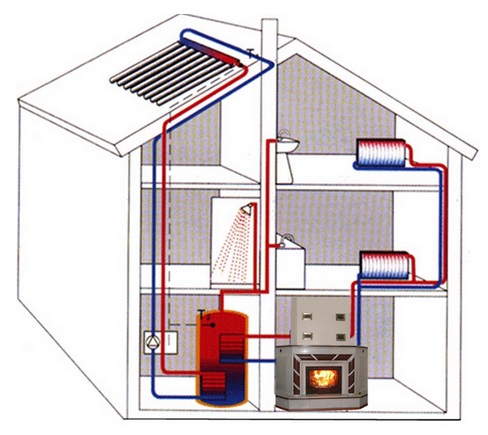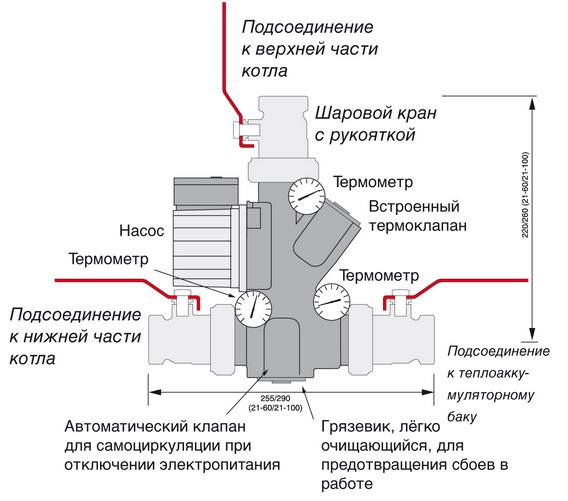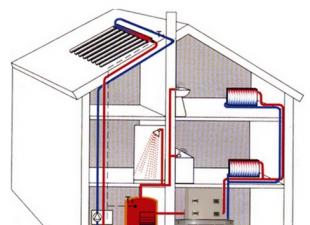Solid fuel boilers cannot operate for a long time without the intervention of a person who must periodically load firewood into the firebox. If this is not done, the system will begin to cool down, the temperature in the house will drop. In the event of a power outage with a fully ignited furnace, there is a danger of the coolant boiling up in the jacket of the unit and its subsequent destruction. All these problems can be solved by installing a heat accumulator for heating boilers. It will also be able to perform the function of protecting cast iron installations from cracking during a sharp temperature drop in the network water.
Piping of a solid fuel boiler with a heat accumulator
Calculation of the buffer capacity for the boiler
The role of the heat accumulator in the general heating scheme is as follows: during the operation of the boiler in normal mode, accumulate thermal energy, and after the furnace is attenuated, give it to the radiators for a certain period of time. Structurally, a heat accumulator for a solid fuel boiler is an insulated water tank with an estimated capacity. It can be installed both in the furnace room and in a separate room of the house. It does not make sense to put such a tank on the street, since the water in it will cool much faster than inside the building.

Given the availability of free space in the house, the calculation of a heat accumulator for a solid fuel boiler in practice is carried out as follows: tank capacity is taken from the ratio of 25-50 liters of water per 1 kW of power required to heat the house. For a more accurate calculation of the buffer capacity for the boiler, it is assumed that the water in the tank will heat up to 90 ⁰С during the operation of the boiler plant, and after the latter is turned off, it will give off heat and cool down to 50 ⁰С. For a temperature difference of 40 ⁰С, the values of the heat given off for different tank volumes are presented in the table.
Table of heat output values for different tank sizes
Even if there is space in the building to install a large capacity, it does not always make sense. It should be remembered that a large amount of water will need to be heated, then the power of the boiler itself should initially be 2 times more than what is needed to heat the home. Too small a tank will not perform its functions, as it will not be able to accumulate enough heat.
The choice of a heat accumulator for a solid fuel boiler is influenced by the availability of free space in the room. When buying a large storage tank, it will be necessary to provide for a foundation, since equipment with a significant mass cannot be placed on ordinary floors. If, according to the calculation, a tank with a volume of 1 m 3 is required, and there is not enough space for its installation, then you can purchase 2 products of 0.5 m 3 each, placing them in different places.

Heat accumulator for solid fuel boiler
Another point is the presence of a hot water system in the house. In the event that the boiler does not have its own water heating circuit, it is possible to purchase a heat accumulator with such a circuit. Of no small importance is the value of the working pressure in the heating system, which in residential buildings traditionally should not exceed 3 bar. In some cases, the pressure reaches 4 bar if a powerful home-made unit is used as a heat source. Then the heat accumulator for the heating system will have to choose a special design - with a toruspherical cover.
Some factory-made hot water accumulators are equipped with an electric heating element installed at the top of the tank. Such a technical solution will not allow the coolant to completely cool down after the boiler stops, the upper zone of the tank will be heated. DHW will be supplied for household needs.
Simple switching circuit with mixing
The storage device can be included in the system according to different schemes. The simplest piping of a solid fuel boiler with a heat accumulator is suitable for working with gravitational coolant supply systems and will operate in the event of a power outage. To do this, the tank must be installed above the heating radiators. The circuit includes a circulation pump, a thermostatic three-way valve and a check valve. At the beginning of the heating cycle, water, driven by the pump, passes through the supply pipeline from the heat source through the three-way valve to the heaters. This continues until the flow temperature reaches a certain value, eg 60°C.

At this temperature, the valve begins to mix cold water into the system from the lower pipe of the tank, observing the set temperature of 60 ⁰С at the outlet. Through the upper pipe, directly connected to the boiler, heated water will begin to flow into the tank, the battery will begin to charge. When the firewood is completely burned in the firebox, the temperature in the supply pipe will begin to drop. When it becomes less than 60 ⁰С, the thermostat will gradually shut off the supply from the heat source and open the flow of water from the tank. That, in turn, will be gradually filled with cold water from the boiler and at the end of the cycle the three-way valve will return to its original position.
The non-return valve, connected in parallel with the three-way thermostat, is activated when the circulation pump stops. Then the boiler with a heat accumulator will work directly, the coolant will go to the heating devices directly from the tank, which will be replenished with water from the heat source. The thermostat in this case does not take part in the operation of the circuit.
Schematic with hydraulic separation
Another, more complex connection scheme, implies an uninterrupted supply of electricity. If this is not possible, then it is necessary to provide for connection to the network through an uninterruptible power supply. Another option is to use diesel or gasoline power plants. In the previous case, the connection of the heat accumulator to the solid fuel boiler was independent, that is, the system could work separately from the tank. In this scheme, the battery acts as a buffer tank (hydraulic separator). A special mixing unit (LADDOMAT) is built into the primary circuit, through which water circulates when the boiler is ignited.

Connecting a heat accumulator to a solid fuel boiler
Block elements:
- circulation pump;
- three-way thermostatic valve;
- check valve;
- sump;
- Ball Valves;
- temperature control devices.
Differences from the previous scheme - all devices are assembled in one unit, and the coolant goes to the tank, and not to the heating system. The principle of operation of the stirring unit remains unchanged. Such a piping of a solid fuel boiler with a heat accumulator allows you to connect as many heating branches as you like at the outlet of the tank. For example, to supply radiators and underfloor or air heating systems. In addition, each branch has its own circulation pump. All circuits are separated hydraulically, excess heat from the source is accumulated in the tank and used if necessary.
Advantages and disadvantages
A heating system with a heat accumulator, in which a solid fuel installation serves as a heat source, has a lot of advantages:
- Increased comfort in the house, because after the combustion of fuel, the heating system continues to heat the house with hot water from the tank. No need to get up in the middle of the night and load a portion of firewood into the firebox.
- The presence of a container protects the water jacket of the boiler from boiling and destruction. If the electricity is suddenly cut off or the thermostatic heads installed on the radiators cut off the coolant due to reaching the desired temperature, the heat source will heat the water in the tank. During this time, the power supply may be restored or the diesel generator will be started.
- The supply of cold water from the return pipeline to the red-hot cast-iron heat exchanger is excluded after the sudden activation of the circulation pump.
- Heat accumulators can be used as hydraulic separators in the heating system (hydraulic arrows). This makes the operation of all circuit branches independent, which provides additional savings in thermal energy.
The higher cost of installing the entire system and the requirements for equipment placement are the only disadvantages of using storage tanks. However, these investments and inconveniences will be followed by minimal operating costs in the long run.
 budivel.ru About the insulation and heating of the house.
budivel.ru About the insulation and heating of the house.


